













Post War Period
|
 |
|||||
 |
|||||
 |
|||||
 |
|||||
 |
|||||
 |
|||||
 |
|||||
 |
|||||
 |
|||||
 |
|||||
 |
|||||
 |
|||||
 |
|||||
 |
|||||
Transition from War | Government | Economics | Art and Literature | Popular Culture | Important People and Events
Transition
from War
Part of the conditions of surrender signed by the Japanese on September
2, 1945 included the occupation of Japan by the Allied military forces.
What
followed
is often referred to a period of demilitarization and democratization under
General Douglas Mac Arthur from 1945-1947. Japan's army and navy ministries
were
abolished. War industries began a process of converting to civilian production.
War crimes trials also began which led to the conviction of 4,200 officials.
700 of those were executed. The American forces also sought to remove
the expression of patriotism from public life including schools. Shinto was
disestablished as state religion and on January 1, 1946, Emperor
Hirohito declared he was not a divine figure. Reforms
were made to the Meiji Constitution. The new constitution is often referred
to as the "Mac
Arthur
Constitution". Some of the reforms included economic
reforms, agricultural land redistribution, the reestablishment of trade
unions, and restrictions on zaibatsu.
These restrictions were eased as economic recovery increased. In September
1951,
a conference was held in San Francisco to reach a peace accord with Japan.
Fifty-one nations attended the conference including China, India, the
USSR, and the United States. The treaty that resulted became formally
known as
the Treaty of Peace and
informally as the Treaty of San Francisco. In the treaty, Japan renounced its
land claims including those gained by League
of Nations mandate.
These land claims included Korea, Taiwan, and the Kuril
Islands. Japan was allowed to enter into collective security agreements
and defends itself. This treaty allowed Japan to regain its independence. The
Occupation of Japan by the United States ended in 1952. Most people deem
it successful due to the fact that Japan has not fought a war since World
War II, remains a close ally of the US and has not changed most of the
reforms made during the Occupation.
Government
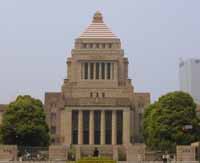 Perhaps
one of the biggest changes in Japan since World War II was the government. The
new constitution stated that
the power of the government rested with the people and not with the emperor.
The emperor, similar to the Queen or King of England, continued as a symbol of
Japan with no political power. The Japanese government has legislative, executive,
and judicial branches as well as local governments. Click
here for a detailed
explanation of the Japanese National Government. After World War II, local
governments were encouraged in Japan. Japan's government is unitary
rather than federal. The local governments depend largely on the national government
in administrative and financial matters. There are forty-seven
local administrations.
Primarily they are called prefectures or
ken in Japanese. There are forty-three
rural prefectures. Tokyo
is
the
the
largest division and is called a metropolitan district.
The two second largest
cities, Kyoto and Osaka make up two urban prefectures.
Lastly, Hokkaido, the northernmost island in Japan makes up a district. Each
large city is divided
into wards which are split into towns, precincts, or sub districts. Each local
jurisdiction has a governor and an assembly that are elected every four years.
All
Japanese citizens who are twenty or older with at least three-months of residency
can
vote. The Japanese people
gained new freedoms including free speech and equal rights for women. While the
military
was abolished, the local police became subject to careful regulation. Within
modern Japanese government many political parties have developed. The Japan Socialist
Party
and Japan Communist Party were
outlawed before World War II and quickly
reestablished the parties. The conservative parties
also revived themselves.The Liberal Party
and the Japan Progressive Party
were actually reinvention of the old Seiyokai and Rikken Minseito. Over time,
political parties in Japan have continued to split. The Liberal Party
and the
Japan Democratic Party merged
in 1955 to form the
Liberal Democratic Party. They
successfully held power from 1955 through 1993. Click
here to view a web site of
Japanese Laws.
Perhaps
one of the biggest changes in Japan since World War II was the government. The
new constitution stated that
the power of the government rested with the people and not with the emperor.
The emperor, similar to the Queen or King of England, continued as a symbol of
Japan with no political power. The Japanese government has legislative, executive,
and judicial branches as well as local governments. Click
here for a detailed
explanation of the Japanese National Government. After World War II, local
governments were encouraged in Japan. Japan's government is unitary
rather than federal. The local governments depend largely on the national government
in administrative and financial matters. There are forty-seven
local administrations.
Primarily they are called prefectures or
ken in Japanese. There are forty-three
rural prefectures. Tokyo
is
the
the
largest division and is called a metropolitan district.
The two second largest
cities, Kyoto and Osaka make up two urban prefectures.
Lastly, Hokkaido, the northernmost island in Japan makes up a district. Each
large city is divided
into wards which are split into towns, precincts, or sub districts. Each local
jurisdiction has a governor and an assembly that are elected every four years.
All
Japanese citizens who are twenty or older with at least three-months of residency
can
vote. The Japanese people
gained new freedoms including free speech and equal rights for women. While the
military
was abolished, the local police became subject to careful regulation. Within
modern Japanese government many political parties have developed. The Japan Socialist
Party
and Japan Communist Party were
outlawed before World War II and quickly
reestablished the parties. The conservative parties
also revived themselves.The Liberal Party
and the Japan Progressive Party
were actually reinvention of the old Seiyokai and Rikken Minseito. Over time,
political parties in Japan have continued to split. The Liberal Party
and the
Japan Democratic Party merged
in 1955 to form the
Liberal Democratic Party. They
successfully held power from 1955 through 1993. Click
here to view a web site of
Japanese Laws.
Economics
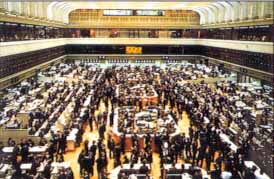 In
the years after World War II, the Japanese economy has seen tremendous growth.
One of the first changes made to the economy of Japan was land use. Before
World War II, two-thirds of the land in Japan was rented by the farmer who farmed
it. The average farm was only one acre in size and the rent was almost half of
the crops grown. In industry, laws were passed to allow free trade unions. The
High
Growth
Age
refers
to
the
time
from
the
late
1950s
to the early 1970s when there was a booming economy. During this time period,
the
1964
Olympic
Games were held in Tokyo. In 1961 the Basic
Agricultural Law was enacted and
in 1964 the New Tokaido Railway (Shinkansen) began. In 1970 the World's Fair
was
held in Osaka. A
very
significant
year
was
1972.
This
is
the
year
that relations with China normalized. In 1973 with OPEC's
increased oil prices, Japan experienced its first recession since
World War II. In the 1980's the conservative government
was pressured by the United States to open more it Japan's markets to more United
States imports. The Japanese government had a growing trade surplus.
Historically, the Japanese government protects its key industries. During the
post war period, Japan's key industries grew to include automobiles and electronics.
In the late 1980s, the Japanese faced economic problems. Unemployment rose to
3.2 percent in 1987 and on October 20, 1987, the Tokyo Stock Market (pictured
above) crashed. In the 1990's into the new century, the Japanese economy has
continued to grow but Tokyo and Osaka became two of the most expensive cities
to live in the world. Since
1970,
the Gross
Domestic Product (GDP) of Japan is second only to the
United States.
In
the years after World War II, the Japanese economy has seen tremendous growth.
One of the first changes made to the economy of Japan was land use. Before
World War II, two-thirds of the land in Japan was rented by the farmer who farmed
it. The average farm was only one acre in size and the rent was almost half of
the crops grown. In industry, laws were passed to allow free trade unions. The
High
Growth
Age
refers
to
the
time
from
the
late
1950s
to the early 1970s when there was a booming economy. During this time period,
the
1964
Olympic
Games were held in Tokyo. In 1961 the Basic
Agricultural Law was enacted and
in 1964 the New Tokaido Railway (Shinkansen) began. In 1970 the World's Fair
was
held in Osaka. A
very
significant
year
was
1972.
This
is
the
year
that relations with China normalized. In 1973 with OPEC's
increased oil prices, Japan experienced its first recession since
World War II. In the 1980's the conservative government
was pressured by the United States to open more it Japan's markets to more United
States imports. The Japanese government had a growing trade surplus.
Historically, the Japanese government protects its key industries. During the
post war period, Japan's key industries grew to include automobiles and electronics.
In the late 1980s, the Japanese faced economic problems. Unemployment rose to
3.2 percent in 1987 and on October 20, 1987, the Tokyo Stock Market (pictured
above) crashed. In the 1990's into the new century, the Japanese economy has
continued to grow but Tokyo and Osaka became two of the most expensive cities
to live in the world. Since
1970,
the Gross
Domestic Product (GDP) of Japan is second only to the
United States.
 One
of the best known and most successful industries in modern Japan is the automobile
industry.
The automobile, while in existence in Japan since 1900, did not significantly
effect Japan's culture until after World War II. The Japanese giants of the
automobile industry began manufacturing cars in the early 1900s but expanded
in the post war period. From 1925-1939, the American "Big Three" (Ford,
GM, Chrysler) began production in Japan. This introduced the Japanese car
industry
to mass production. In the years leading up to World War II, the automobile
industry became an example for increased production for the war effort. After
World War II, the General Headquarters of ALlied Powers (GHQ) allowed 30
different companies to begin truck production. By June 1947, GHQ allowed
small passenger cars to be produced, but only 300 per year. In 1949, the
automobile industry cut wages and laid off workers to deal with a recession.
The labor unions began a strike against manufacturers. The Automobile Industrial
Association founded in April 1948 by five companies including Toyota and
Nissan. In 1950, Mr. Hisato Ichimada, chairman of the Bank of Japan at
the time, claimed that
it was "meaningless for Japan to develop
its automobile industry with the present international division of labor." This
statement actually inspired the opposite. Government guidelines were set
up to introduce new technology to Japan leading to the production of cars
that would compete in the world market. The Korean War greatly helped the
growth of the automobile industry in Japan. For example, only a year into
the war, the Japanese automobile industry saw about $30 million in contracts
involving trucks and automobile parts. Automobile production increased steadily
in the 1950s. This led to the Tokyo Motor Show in 1954. The government had
encouraged the manufacture of "People's Car". These led to mass
production and popularization of the car in the 1960s. By 1973, Japan's output
of four-wheeled
motor vehicles (cars, trucks, and buses) was over 7 million. A drastic change
from just under 500,000 in 1960. Similarly, during the same time period,
the number of four-wheeled vehicles in use in Japan rose from just over 1
million
to almost 25 million. By 1967, Japan was second only to the US in automobile
production. By 1980, Japan surpassed the US in automobile production. While
the oil crisis of the 1970s had a negative initial impact on the car
industry, Japan began experimenting with more fuel efficient cars. This led
to the production of more popular cars and eventually an increase in demand
for Japanese cars that continues into the present day.
One
of the best known and most successful industries in modern Japan is the automobile
industry.
The automobile, while in existence in Japan since 1900, did not significantly
effect Japan's culture until after World War II. The Japanese giants of the
automobile industry began manufacturing cars in the early 1900s but expanded
in the post war period. From 1925-1939, the American "Big Three" (Ford,
GM, Chrysler) began production in Japan. This introduced the Japanese car
industry
to mass production. In the years leading up to World War II, the automobile
industry became an example for increased production for the war effort. After
World War II, the General Headquarters of ALlied Powers (GHQ) allowed 30
different companies to begin truck production. By June 1947, GHQ allowed
small passenger cars to be produced, but only 300 per year. In 1949, the
automobile industry cut wages and laid off workers to deal with a recession.
The labor unions began a strike against manufacturers. The Automobile Industrial
Association founded in April 1948 by five companies including Toyota and
Nissan. In 1950, Mr. Hisato Ichimada, chairman of the Bank of Japan at
the time, claimed that
it was "meaningless for Japan to develop
its automobile industry with the present international division of labor." This
statement actually inspired the opposite. Government guidelines were set
up to introduce new technology to Japan leading to the production of cars
that would compete in the world market. The Korean War greatly helped the
growth of the automobile industry in Japan. For example, only a year into
the war, the Japanese automobile industry saw about $30 million in contracts
involving trucks and automobile parts. Automobile production increased steadily
in the 1950s. This led to the Tokyo Motor Show in 1954. The government had
encouraged the manufacture of "People's Car". These led to mass
production and popularization of the car in the 1960s. By 1973, Japan's output
of four-wheeled
motor vehicles (cars, trucks, and buses) was over 7 million. A drastic change
from just under 500,000 in 1960. Similarly, during the same time period,
the number of four-wheeled vehicles in use in Japan rose from just over 1
million
to almost 25 million. By 1967, Japan was second only to the US in automobile
production. By 1980, Japan surpassed the US in automobile production. While
the oil crisis of the 1970s had a negative initial impact on the car
industry, Japan began experimenting with more fuel efficient cars. This led
to the production of more popular cars and eventually an increase in demand
for Japanese cars that continues into the present day.
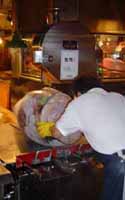 One
of Japan's traditional businesses is the fishing industry. The
Tsukiji Fish Market is the second largest fish market in the world. The
market handles 400 different types of seafood and moves five million pounds
(2, 268,000 kilograms) of seafood each day. This amount of fish translates into
approximately 30 million US dollars per day. The fish market has many different
vendors that people can buy a variety of fresh fish from. The vendor will often
cut and package the fish in front of you. Products and workers move around the
fish market on large scooters. One exceptional
event that happens daily is the fish auction at 5 AM. Fish are auctioned off
daily to the highest bidders. Tuna, the most popular fish to be auctioned, can
weigh from 200 to 1,000 pounds (90 -450 kilograms) each. Over 200 tuna can be
sold in under a half of a hour. The live auctions were open to the public until
May of 2005.
One
of Japan's traditional businesses is the fishing industry. The
Tsukiji Fish Market is the second largest fish market in the world. The
market handles 400 different types of seafood and moves five million pounds
(2, 268,000 kilograms) of seafood each day. This amount of fish translates into
approximately 30 million US dollars per day. The fish market has many different
vendors that people can buy a variety of fresh fish from. The vendor will often
cut and package the fish in front of you. Products and workers move around the
fish market on large scooters. One exceptional
event that happens daily is the fish auction at 5 AM. Fish are auctioned off
daily to the highest bidders. Tuna, the most popular fish to be auctioned, can
weigh from 200 to 1,000 pounds (90 -450 kilograms) each. Over 200 tuna can be
sold in under a half of a hour. The live auctions were open to the public until
May of 2005.
Art and Literature is still being researched and developed.
Popular Culture
EDUCATION | FAMILY | TELEVISION
| MOVIES | KARAOKE
Within education, laws concerning the control and regulation of education changed. "Moral training" in schools was abolished. Instead children were educated in democracy. Control of education as well as censorship of textbooks was switched from the national government to the local governments. The modern Japanese educational system is similar to the United States system. Elementary school is comprised of six years while junior and senior high school are three years each. University is usually four years and junior college is two. Completing school through junior high school is required by law. Over 90% of the students in Japan graduate from high school while 40% will graduate from a junior college or university. The number of male students are higher than female students at university while more females attend junior college than males. The school year itself begins in April and consists of three terms. Each term is separated by a break; two short breaks in winter and spring and a month long break in summer. Most high schools, universities and some private elementary and junior high schools require students to take entrance examinations. To prepare for the exams, students will attend special preparation schools called juku in addition to their regular classes. .
Family structure also changed. The head of the household, usually the father, had complete control of everything. Fathers could withhold consent for children to be married and would control the family finances. After World War II, laws were changed to make each family member more equal. In general, the family in Japan is more important than the individual. Family is the basic unit of society and the basis of how people conduct themselves in the world. For that reason, employers will choose someone who is married over unmarried and a person who comes from a two-parent household. The evolution of the family has changed since the end of World War II. Click here to read about the types of families on Japan.
 Television met
with great success in Japan. By 1990, only 1 percent of households were without
a color television
set. There are two main broadcasting systems. There is one public network (Japan
Broadcasting Network or NHK) and five private networks. Both the public
network and the private networks must comply with the Broadcasting Law of
1950. Several
councils
oversee general programming, but following their recommendations
is voluntary. Most of the programming is centered on pure entertainment.
Around one quarter of the programming involves cultural programs. The last
part of programming, again around twenty-five percent, revolves around news
and education programs. In order to retain a broadcasting licence, the
networks are required to devote a certain amount of time to educational programs.
Programming is similar to the United States. Early mornings have news programs
followed by soap operas and dramas at midday. After school hours have children's
programs followed by news programs during the mid evening hours. Prime time
begriming at 7PM and extending to 9 PM are shows that have the biggest stars
and can be dramas or comedies. AFter a late night news program, most programs
are geared toward mature audiences or are re-runs of earlier shows. Most
Japanese programming centered around family life, samurai, and the Japanese
underworld (yakuza)
themes. There are many premium or pay TV channels. One
is TV Japan. Some
of the Japanese television shows that have transferred to the United States
include the Iron Chef (a cooking show), Endurance (a game show) and cartoons
(Dragon
Ball, Sailor Moon, Pokémon,
Speed Racer, and Yu-Gi-Oh). Foreign
movies are shown on pay TV channels. They can be watched in either Japanese
or the original language they were
made in.
Television met
with great success in Japan. By 1990, only 1 percent of households were without
a color television
set. There are two main broadcasting systems. There is one public network (Japan
Broadcasting Network or NHK) and five private networks. Both the public
network and the private networks must comply with the Broadcasting Law of
1950. Several
councils
oversee general programming, but following their recommendations
is voluntary. Most of the programming is centered on pure entertainment.
Around one quarter of the programming involves cultural programs. The last
part of programming, again around twenty-five percent, revolves around news
and education programs. In order to retain a broadcasting licence, the
networks are required to devote a certain amount of time to educational programs.
Programming is similar to the United States. Early mornings have news programs
followed by soap operas and dramas at midday. After school hours have children's
programs followed by news programs during the mid evening hours. Prime time
begriming at 7PM and extending to 9 PM are shows that have the biggest stars
and can be dramas or comedies. AFter a late night news program, most programs
are geared toward mature audiences or are re-runs of earlier shows. Most
Japanese programming centered around family life, samurai, and the Japanese
underworld (yakuza)
themes. There are many premium or pay TV channels. One
is TV Japan. Some
of the Japanese television shows that have transferred to the United States
include the Iron Chef (a cooking show), Endurance (a game show) and cartoons
(Dragon
Ball, Sailor Moon, Pokémon,
Speed Racer, and Yu-Gi-Oh). Foreign
movies are shown on pay TV channels. They can be watched in either Japanese
or the original language they were
made in.
Movies
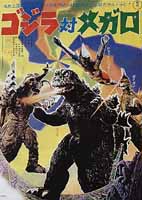 While the Japanese film industry began in 1899 with silent films, it is not until
after World War II, that it grows in size and notoriety. During the US occupation
of Japan, the Japanese were exposed to American animation that had been banned
during the war. During the 1950s the movie industry began to boom. The most famous
film to come out of this time period is Gojira or Godzilla.
This first film spawns
a series of films well into present day. Woman
in
the
Dunes,
released in 1964 receives Academy Award nominations
for Best Director and Best Foreign Film. In 1965, a three-hour
documentary called Tokyo Olympiad is released. The 1970s in Japanese film brings
controversy in the film In the Realm of Senses. The film contained adult
material that Japan censored. An uncut version was made but has not been shown
in Japan. The film industry in Japan saw a decline in production in the 1980s.
Television's popularity led to a decline in the number of films made. The
1980s
saw
the
rise
of
Hayao
Miyazaki
who
made
the Valley
of
the
Wind in 1984. In 2001, Hayao directed Spirited Away which won the
Academy
Award for Best Animated Feature.
While the Japanese film industry began in 1899 with silent films, it is not until
after World War II, that it grows in size and notoriety. During the US occupation
of Japan, the Japanese were exposed to American animation that had been banned
during the war. During the 1950s the movie industry began to boom. The most famous
film to come out of this time period is Gojira or Godzilla.
This first film spawns
a series of films well into present day. Woman
in
the
Dunes,
released in 1964 receives Academy Award nominations
for Best Director and Best Foreign Film. In 1965, a three-hour
documentary called Tokyo Olympiad is released. The 1970s in Japanese film brings
controversy in the film In the Realm of Senses. The film contained adult
material that Japan censored. An uncut version was made but has not been shown
in Japan. The film industry in Japan saw a decline in production in the 1980s.
Television's popularity led to a decline in the number of films made. The
1980s
saw
the
rise
of
Hayao
Miyazaki
who
made
the Valley
of
the
Wind in 1984. In 2001, Hayao directed Spirited Away which won the
Academy
Award for Best Animated Feature.
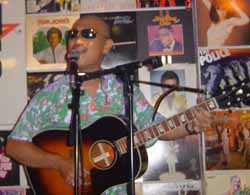 |
Karaoke is
popular past time in Japan that is spreading around the world. In Japanese karaoke comes
from two words. "Karappo" meaning empty contributes the kara
and "oke" comes from "okesutura," or orchestra.
According to legend karaoke began
in a Kobe restaurant over twenty years ago when the strolling guitarist
did not
show up and the owner played instrumental tapes of songs prompting
sing along from the customers. Karaoke night
spots spread to Kansai. It became a typical form of entertainment for
Japanese business people. The business men and women would go to a karaoke bar
and sing to relieve the stress of the work day. |
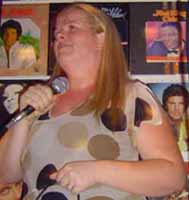 While the practice of karaoke began
in the bar and restaurant scene, it has spread to homes. People can
buy karaoke machines
and cds and practice at home. With poorly soundproofed houses, karaoke boxes
on the street began appearing in 1984. Karaoke's
popularity is said to be based in the Japanese culture of love of singing
and watching others sing. Karaoke is
often performed in multiple languages. Karaoke has
spread throughout Asia and into the west. While the practice of karaoke began
in the bar and restaurant scene, it has spread to homes. People can
buy karaoke machines
and cds and practice at home. With poorly soundproofed houses, karaoke boxes
on the street began appearing in 1984. Karaoke's
popularity is said to be based in the Japanese culture of love of singing
and watching others sing. Karaoke is
often performed in multiple languages. Karaoke has
spread throughout Asia and into the west. |
|
Important People and Events is still being researched and developed.
to return to Mrs. O'Donnell's Home Page.
Maintained according to the Lakeland
Central School District Web Page Policies and Guidelines.
Clicking on the above links will direct you to site(s) outside the Lakeland
Central School District and the Lakeland High School server. The Lakeland Central
School District is not responsible for contents on external sites and servers,
nor does the district endorse the sponsors or advertising on these sites.
This site was designed and maintained by Maureen
O'Donnell, a teacher at Lakeland
High School.
July 2005 Created - |
Saturday, February 25, 2006
Last Revised